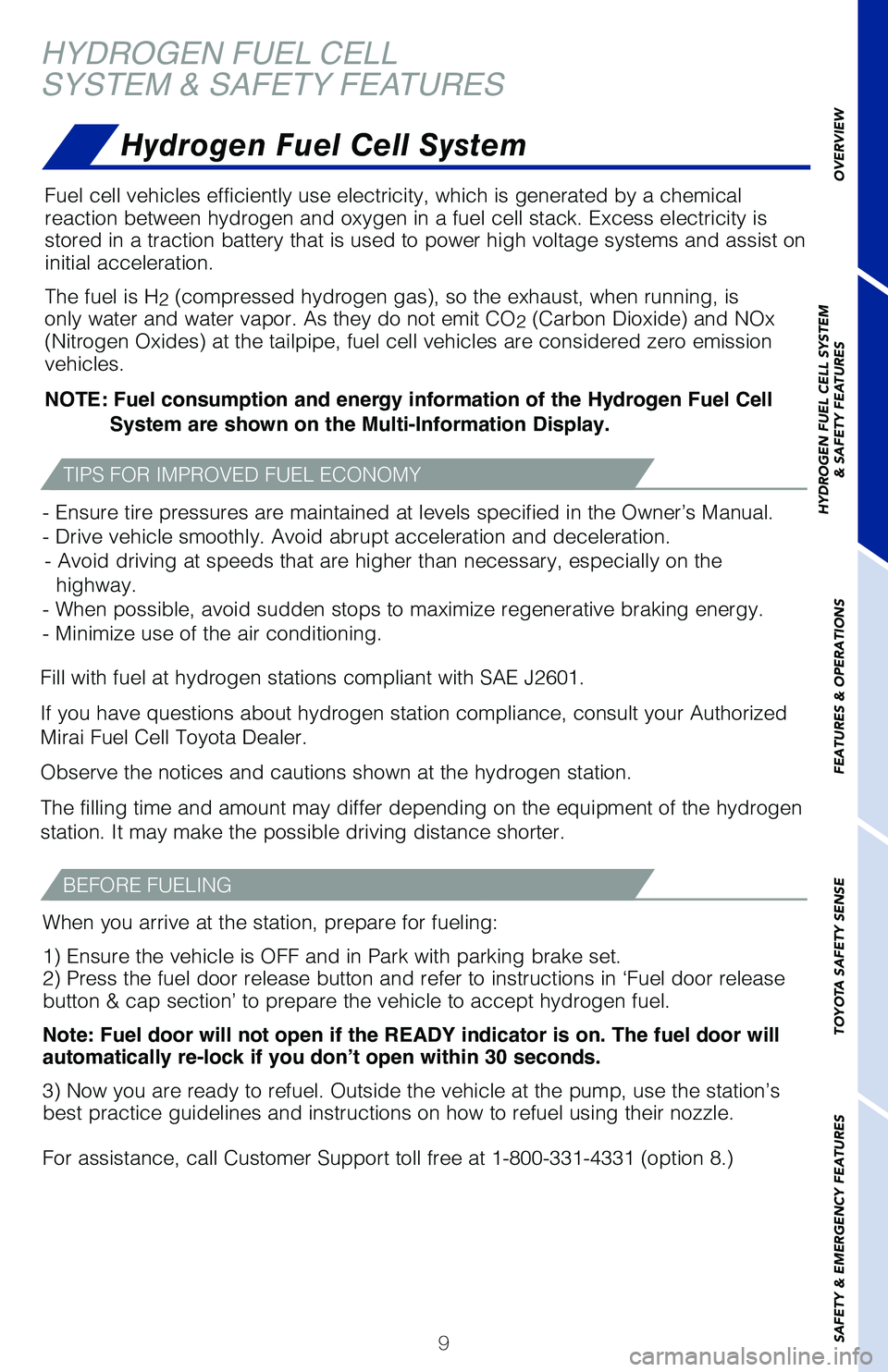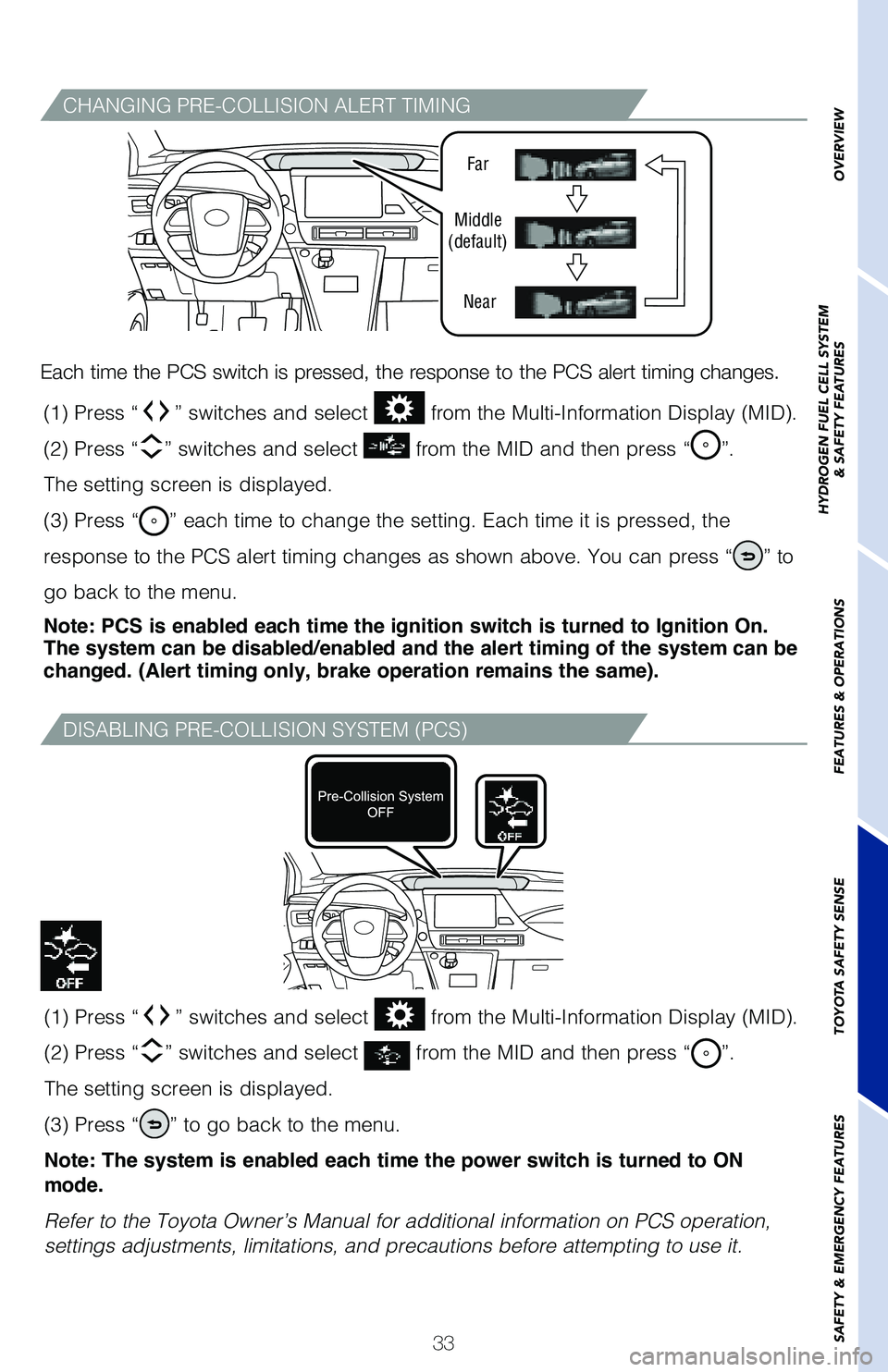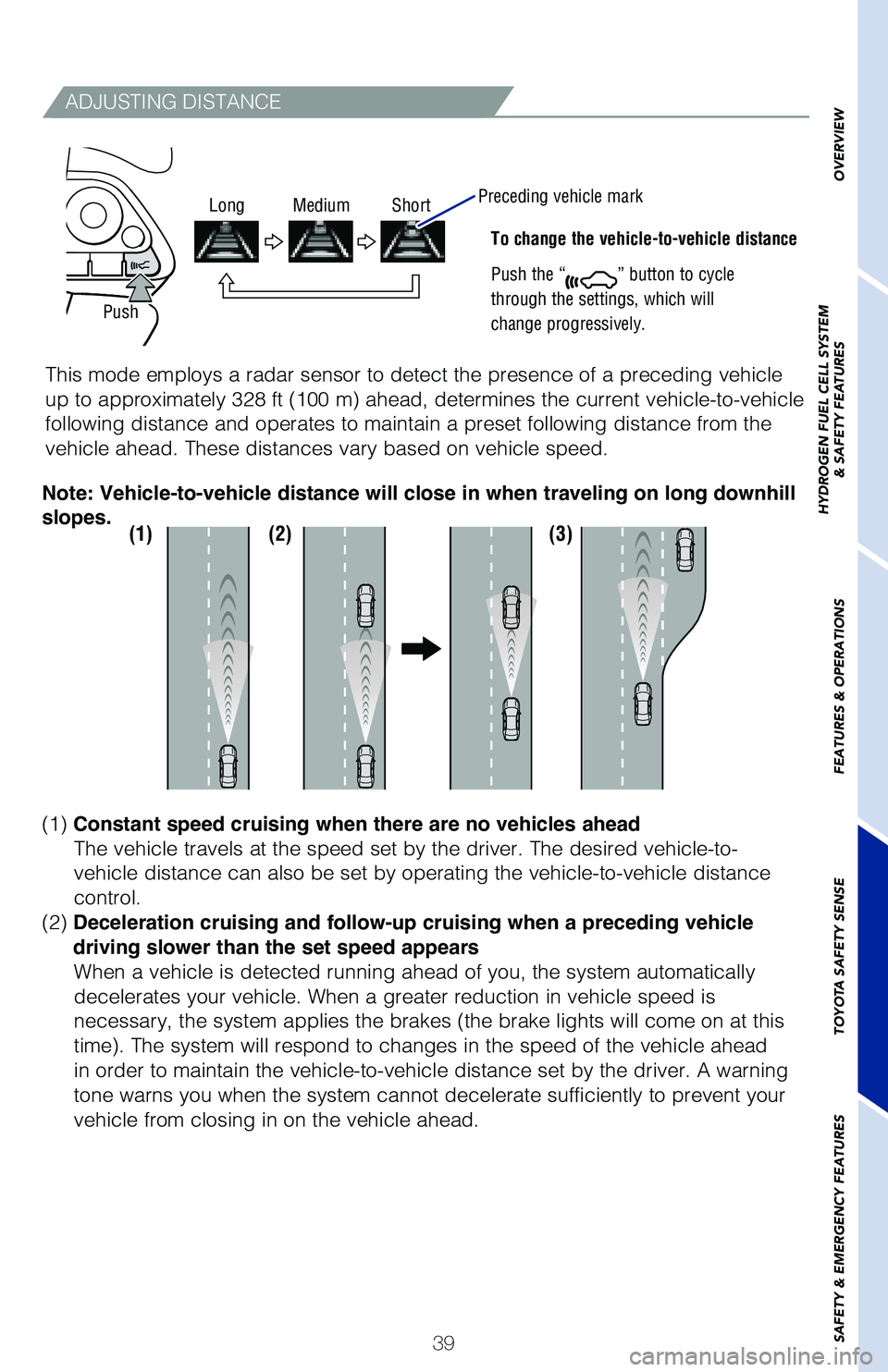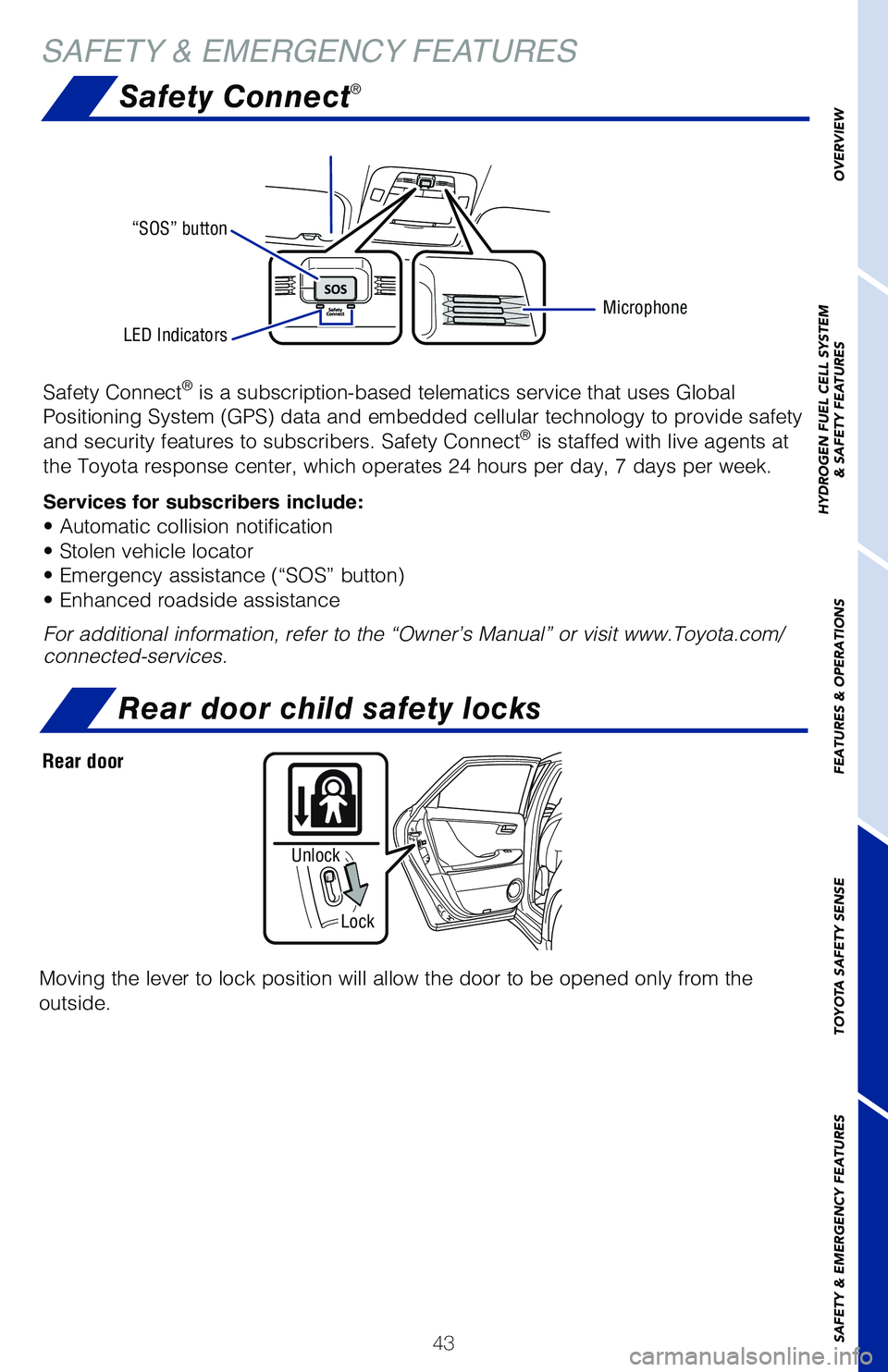ESP TOYOTA MIRAI 2020 Owners Manual (in English)
[x] Cancel search | Manufacturer: TOYOTA, Model Year: 2020, Model line: MIRAI, Model: TOYOTA MIRAI 2020Pages: 56, PDF Size: 3.21 MB
Page 11 of 56

9
HYDROGEN FUEL CELL
SYSTEM & SAFETY FEATURES
Fuel cell vehicles efficiently use electricity, which is generated by a \
chemical
reaction between hydrogen and oxygen in a fuel cell stack. Excess electr\
icity is
stored in a traction battery that is used to power high voltage systems \
and assist on
initial acceleration.
The fuel is H
2 (compressed hydrogen gas), so the exhaust, when running, is
only water and water vapor. As they do not emit CO
2 (Carbon Dioxide) and NOx
(Nitrogen Oxides) at the tailpipe, fuel cell vehicles are considered zero emission
vehicles.
NOTE: Fuel consumption and energy information of the Hydrogen Fuel Cell
System are shown on the Multi-Information Display.
Fill with fuel at hydrogen stations compliant with SAE J2601.
If you have questions about hydrogen station compliance, consult your Authorized
Mirai Fuel Cell Toyota Dealer.
Observe the notices and cautions shown at the hydrogen station.
The filling time and amount may differ depending on the equipment of the\
hydrogen
station. It may make the possible driving distance shorter. - Ensure tire pressures are maintained at levels specified in the Owner’\
s Manual.
- Drive vehicle smoothly. Avoid abrupt acceleration and deceleration.
- Avoid driving at speeds that are higher than necessary, especially on \
the highway.
- When possible, avoid sudden stops to maximize regenerative braking energy.
- Minimize use of the air conditioning.
When you arrive at the station, prepare for fueling:
1) Ensure the vehicle is OFF and in Park with parking brake set.
2) Press the fuel door release button and refer to instructions in ‘Fuel door release button & cap section’ to prepare the vehicle to accept hydrogen fuel.\
Note: Fuel door will not open if the READY indicator is on. The fuel door will
automatically re-lock if you don’t open within 30 seconds.
3) Now you are ready to refuel. Outside the vehicle at the pump, use the station’s best practice guidelines and instructions on how to refuel using their nozzle.
For assistance, call Customer Support toll free at 1-800-331-4331 (option 8.)
OVERVIEW
HYDROGEN FUEL CELL SYSTEM
& SAFETY FEATURES
FEATURES & OPERATIONS
TOYOTA SAFETY SENSE
SAFETY & EMERGENCY FEATURES
Hydrogen Fuel Cell System
TIPS FOR IMPROVED FUEL ECONOMY
BEFORE FUELING
Page 16 of 56

14
FEATURES & OPERATIONSAutomatic transmission
* Br Mode is the equivalent of downshifting. Shift to “Br” when st\
rong regenerative
braking is desired (i.e. downhill driving, coasting to a stop, etc.).
Park
Reverse
Neutral
Drive
Br Mode*
Use when a higher level of response is desired, such as when driving in \
mountainous regions or overtaking.
Push
Push
ECO Mode helps achieve low fuel consumption during trips that involve fr\
equent
accelerating and braking.
ECO MODE
POWER MODE
Page 35 of 56

33
CHANGING PRE-COLLISION ALERT TIMING
DISABLING PRE-COLLISION SYSTEM (PCS)
Each time the PCS switch is pressed, the response to the PCS alert timin\
g changes.
Far
Middle
(default)
Near
(1) Press “” switches and select from the Multi-Information Display (MID).
(2) Press “
” switches and select from the MID and then press “”.
The setting screen is displayed.
(3) Press “
” each time to change the setting. Each time it is pressed, the
response to the PCS alert timing changes as shown above. You can press “
” to
go back to the menu.
Note: PCS is enabled each time the ignition switch is turned to Ignition On.
The system can be disabled/enabled and the alert timing of the system can be
changed. (Alert timing only, brake operation remains the same).
(1) Press “
” switches and select from the Multi-Information Display (MID).
(2) Press “
” switches and select from the MID and then press “”.
The setting screen is displayed.
(3) Press “
” to go back to the menu.
Note: The system is enabled each time the power switch is turned to ON
mode.
Refer to the Toyota Owner’s Manual for additional information on PCS \
operation,
settings adjustments, limitations, and precautions before attempting to \
use it.
OVERVIEW
HYDROGEN FUEL CELL SYSTEM
& SAFETY FEATURES
FEATURES & OPERATIONS
TOYOTA SAFETY SENSE
SAFETY & EMERGENCY FEATURES
Page 41 of 56

39
ADJUSTING DISTANCE
To change the vehicle-to-vehicle distance
Push the “
” button to cycle
through the settings, which will
change progressively.
This mode employs a radar sensor to detect the presence of a preceding v\
ehicle
up to approximately 328 ft (100 m) ahead, determines the current vehicle-to-vehicle
following distance and operates to maintain a preset following distance \
from the
vehicle ahead. These distances vary based on vehicle speed.
(1)(2)(3)
(1) Constant speed cruising when there are no vehicles ahead
The vehicle travels at the speed set by the driver. The desired vehicle-\
to-
vehicle distance can also be set by operating the vehicle-to-vehicle dis\
tance
control.
(2) Deceleration cruising and follow-up cruising when a preceding vehicle
driving slower than the set speed appears When a vehicle is detected running ahead of you, the system automaticall\
y
decelerates your vehicle. When a greater reduction in vehicle speed is
necessary, the system applies the brakes (the brake lights will come on at this
time). The system will respond to changes in the speed of the vehicle ahead
in order to maintain the vehicle-to-vehicle distance set by the driver. \
A warning
tone warns you when the system cannot decelerate sufficiently to prevent\
your
vehicle from closing in on the vehicle ahead.
Note: Vehicle-to-vehicle distance will close in when traveling on long downhill
slopes.
Push
Long Medium Short
Preceding vehicle mark
OVERVIEW
HYDROGEN FUEL CELL SYSTEM
& SAFETY FEATURES
FEATURES & OPERATIONS
TOYOTA SAFETY SENSE
SAFETY & EMERGENCY FEATURES
Page 45 of 56

43
Safety Connect®
Safety Connect® is a subscription-based telematics service that uses Global
Positioning System (GPS) data and embedded cellular technology to provide safety
and security features to subscribers. Safety Connect
® is staffed with live agents at
the Toyota response center, which operates 24 hours per day, 7 days per \
week.
Services for subscribers include:
• Automatic collision notification
• Stolen vehicle locator
• Emergency assistance (“SOS” button)
• Enhanced roadside assistance
For additional information, refer to the “Owner’s Manual” or vi\
sit www.Toyota.com/
connected-services.
Microphone
LED Indicators “SOS” button
Rear door child safety locks
Moving the lever to lock position will allow the door to be opened only \
from the
outside.
Rear door
Lock
Unlock
SAFETY & EMERGENCY FEATURES
OVERVIEW
HYDROGEN FUEL CELL SYSTEM
& SAFETY FEATURES
FEATURES & OPERATIONS
TOYOTA SAFETY SENSE
SAFETY & EMERGENCY FEATURES
Page 48 of 56

46
Star Safety System™
SAFETY & EMERGENCY FEATURES
Your vehicle comes standard with the Star Safety SystemTM, which combines
Anti-lock Braking System (ABS), Brake Assist (BA), Electronic Brake-force
Distribution (EBD), Smart Stop Technology (SST), Traction Control (TRAC) and
Vehicle Stability Control (VSC).
Refer to the Owner’s Manual for more details and important information on limitations
to these systems.
Enhanced Vehicle Stability Control provides cooperative control of the A\
BS, TRAC,
VSC and EPS.
Enhanced VSC helps to maintain directional stability when loss of tracti\
on occurs
during a turn.
ENHANCED VEHICLE STABILITY CONTROL (VSC)
Toyota’s ABS sensors detect which wheels are locking up and limits wh\
eel lockup
by “pulsing” each wheel’s brakes independently. Pulsing release\
s brake pressure
repeatedly for fractions of a second. This helps the tires attain the tr\
action that
current road conditions will allow, helping you to stay in directional c\
ontrol.
ANTI-LOCK BRAKE SYSTEM (ABS)
Toyota’s ABS technology has Electronic Brake-force Distribution (EBD) to help
maintain control and balance when braking. EBD responds to sudden stops \
by
redistributing brake force to enhance the braking effectiveness of all f\
our wheels.
ELECTRONIC BRAKE FORCE DISTRIBUTION (EBD)
Brake Assist is designed to detect sudden or “panic” braking, and \
then add braking
pressure to help decrease the vehicle’s stopping distance. When there\
’s only a split
second to react, Brake Assist can add additional brake pressure more qui\
ckly than
just the driver alone can.
BRAKE ASSIST (BA)
SMART STOP TECHNOLOGY (SST)
Smart Stop Technology automatically reduces motor power when the acceler\
ator
and brake pedals are pressed simultaneously under certain conditions.
SST engages when the accelerator is depressed first and the brakes are a\
pplied
firmly for longer than one-half second at speeds greater than five miles\
per hour.
SST doesn’t engage if the brake pedal is depressed before the acceler\
ator pedal,
allowing vehicles to start on a steep hill and safely accelerate without\
rolling
backward.